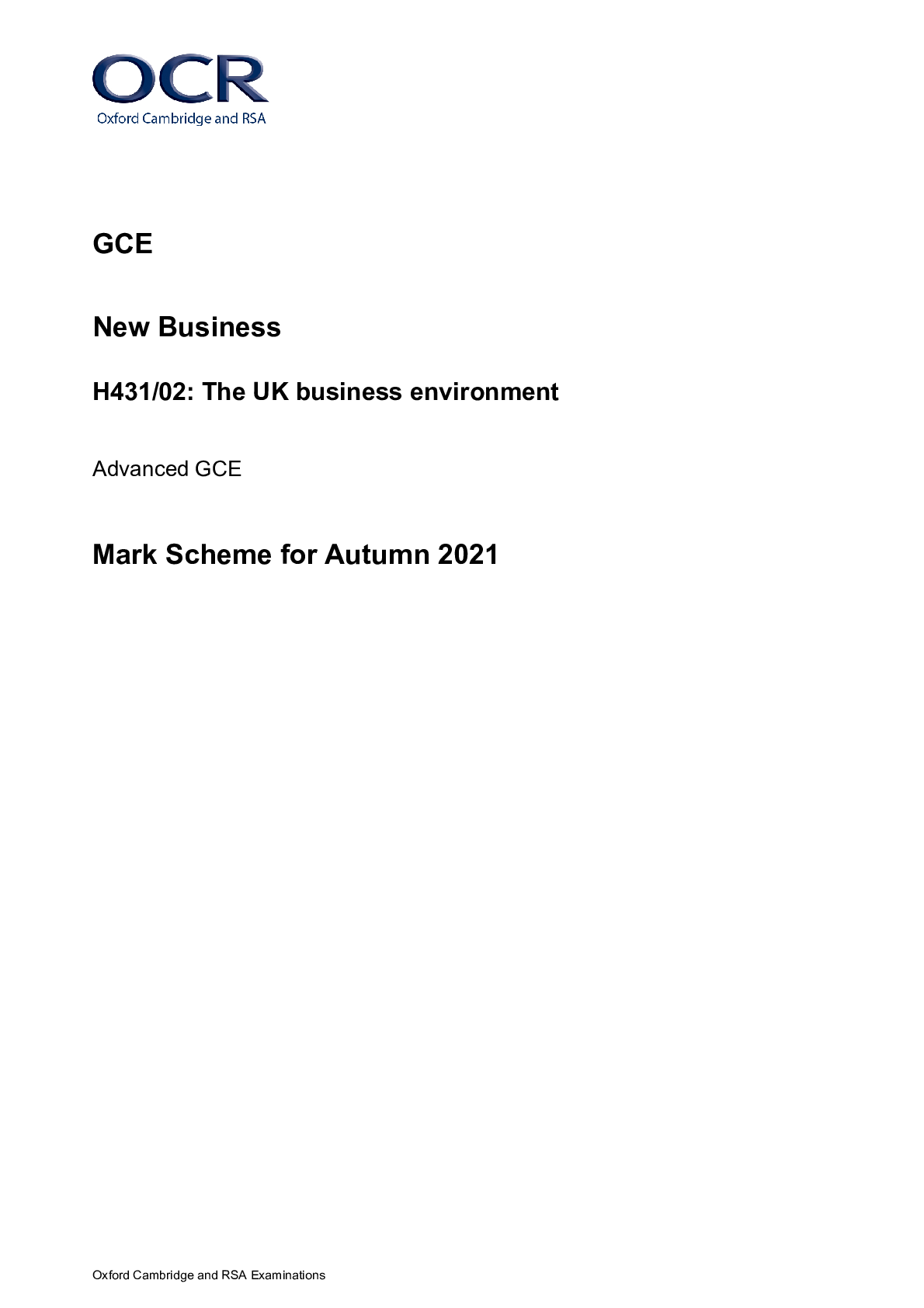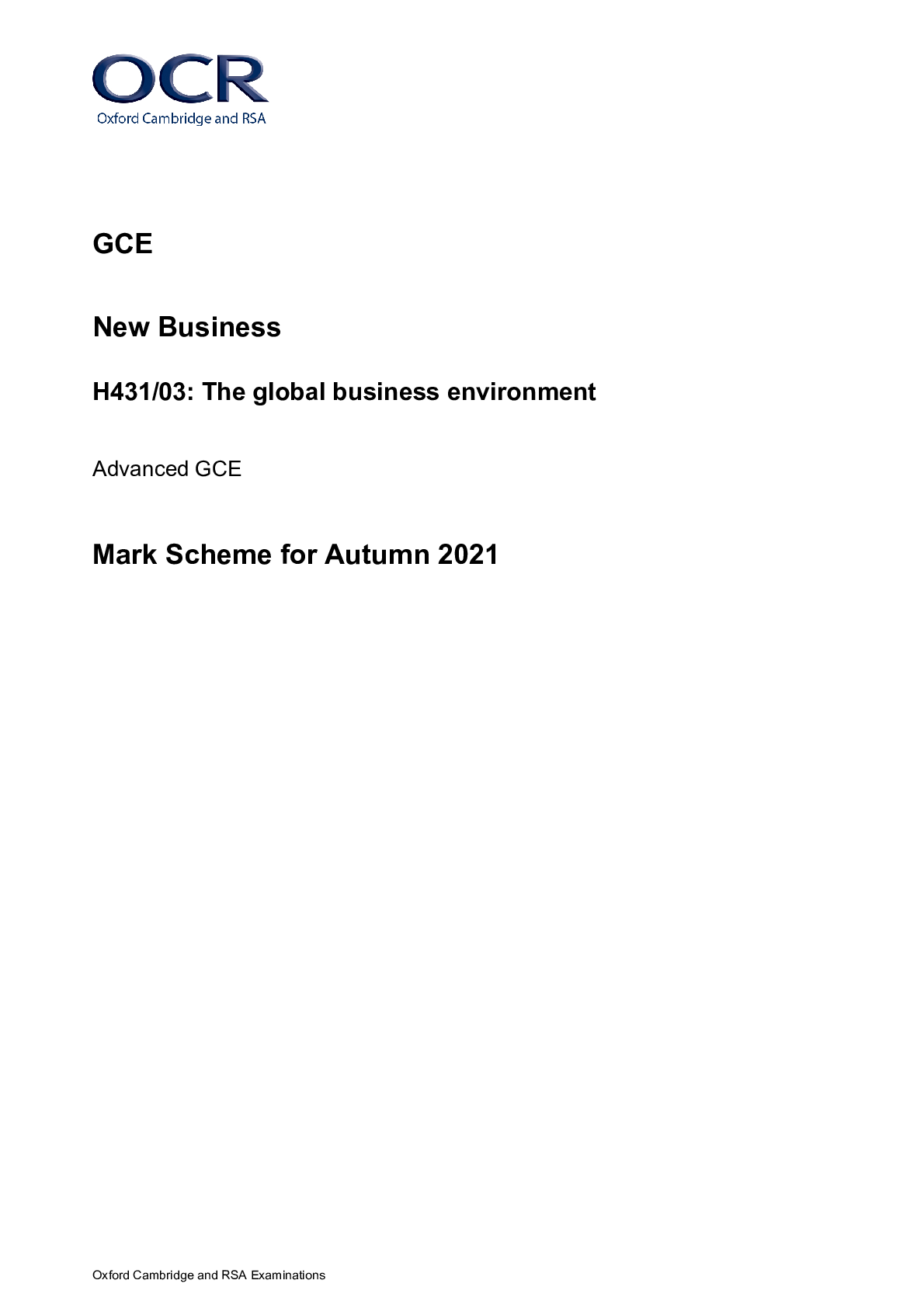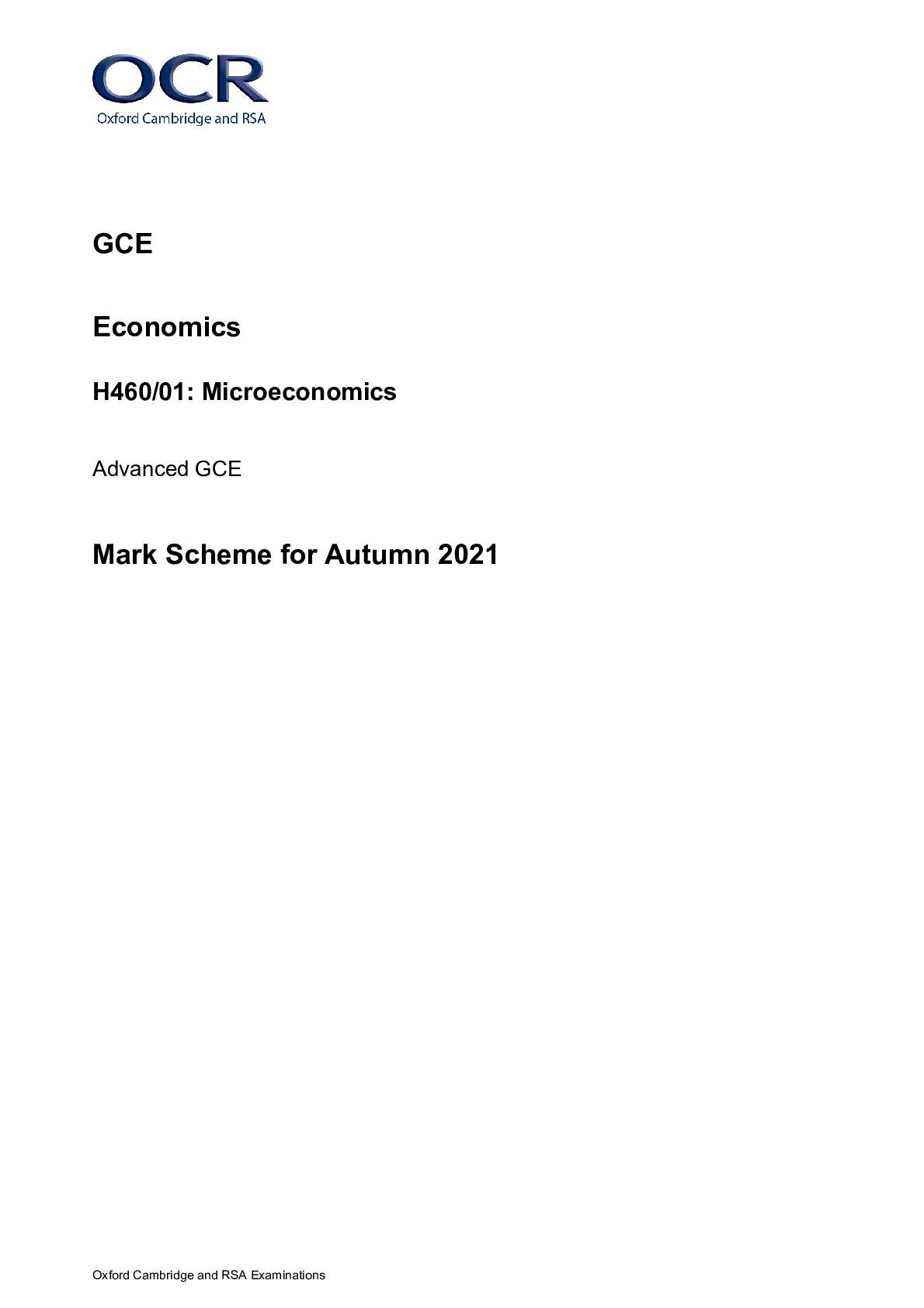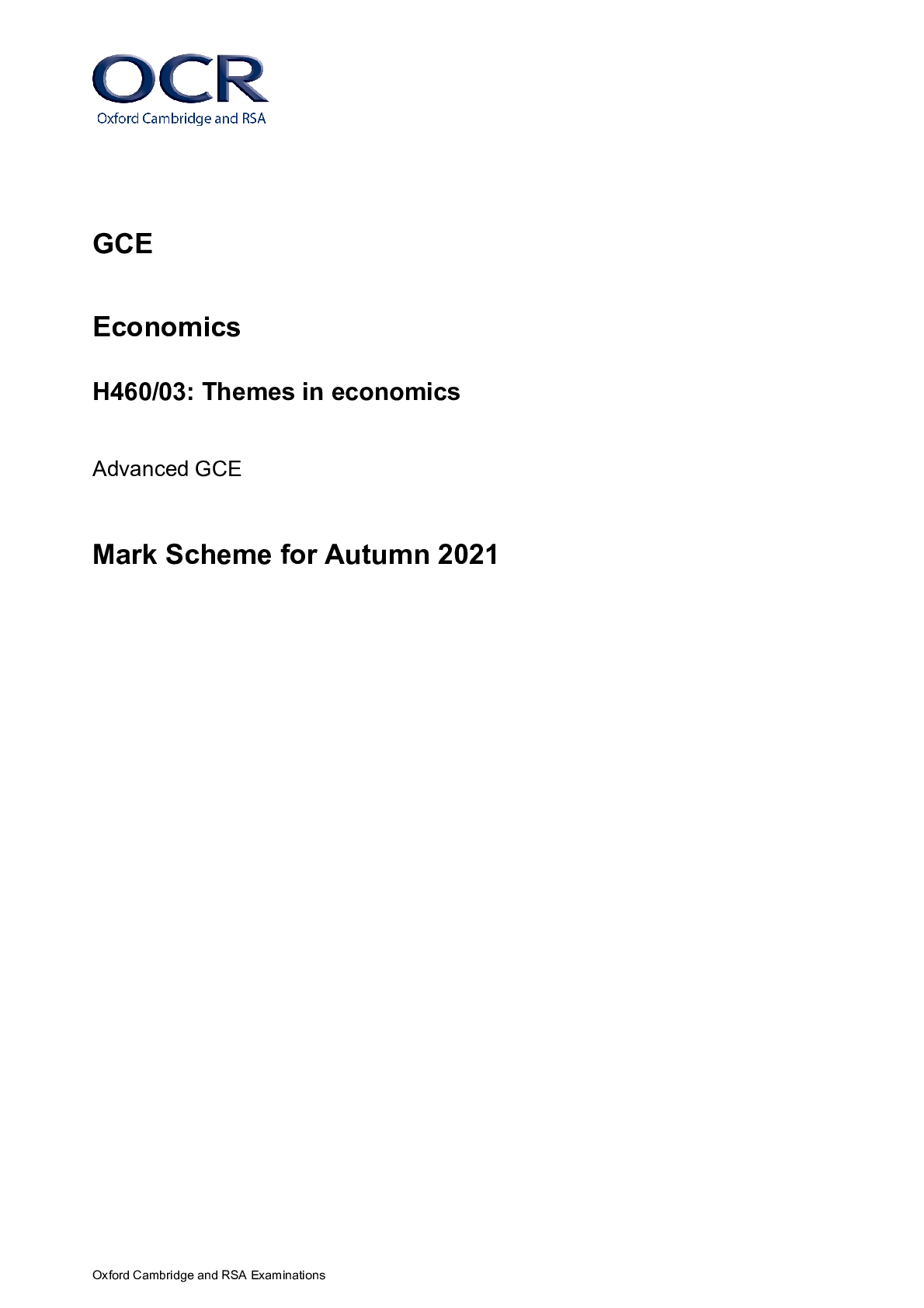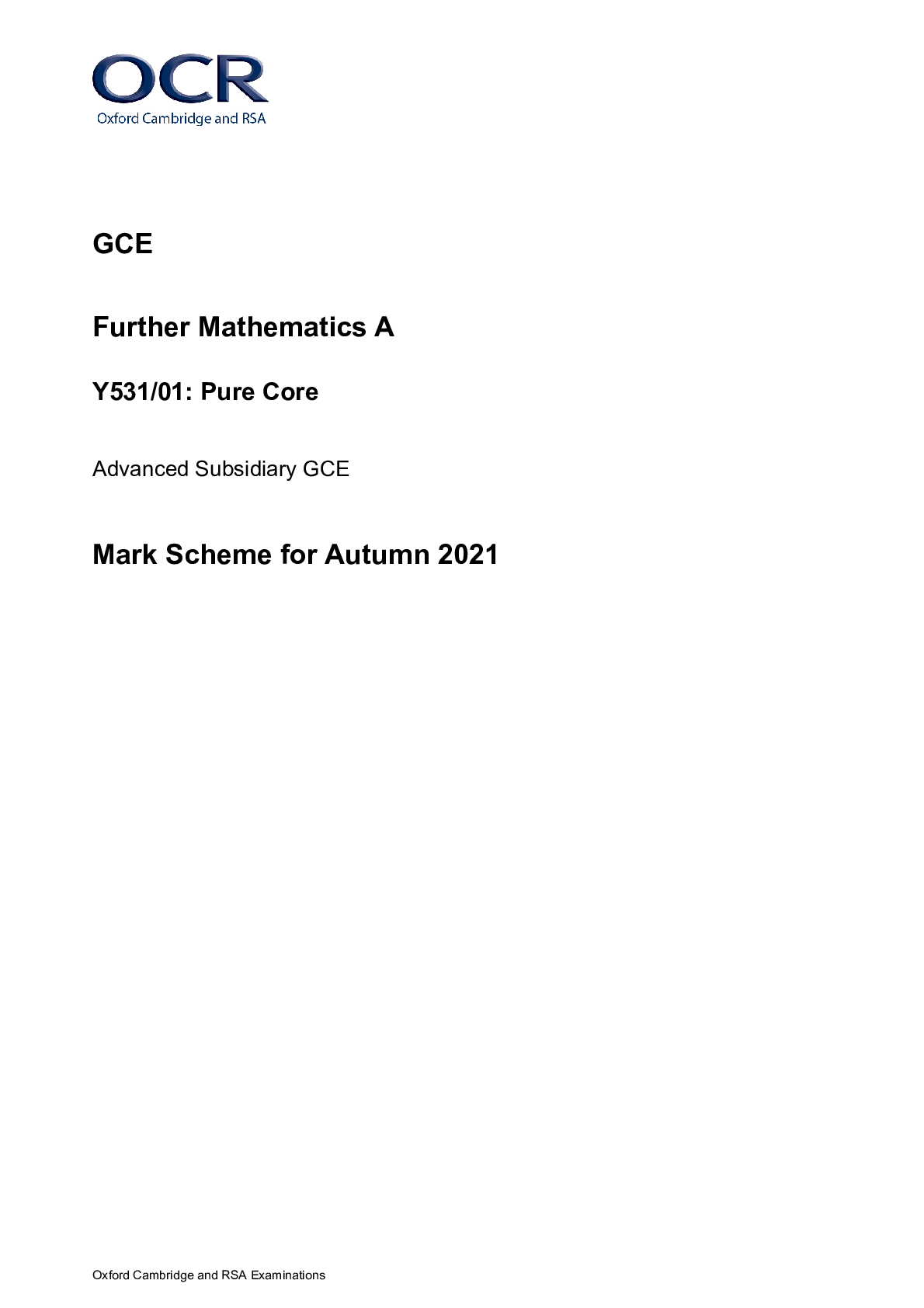Religious Studies > MARK SCHEME > GCE Religious Studies H573/01: Philosophy of religion Advanced GCE Mark Scheme for November 2020 (All)
GCE Religious Studies H573/01: Philosophy of religion Advanced GCE Mark Scheme for November 2020
Document Content and Description Below
GCE Religious Studies H573/01: Philosophy of religion Advanced GCE Mark Scheme for November 2020 Oxford Cambridge and RSA Examinations GCE Religious Studies H573/01: Philosophy of religion ... Advanced GCE Mark Scheme for November 2020Oxford Cambridge and RSA Examinations OCR (Oxford Cambridge and RSA) is a leading UK awarding body, providing a wide range of qualifications to meet the needs of candidates of all ages and abilities. OCR qualifications include AS/A Levels, Diplomas, GCSEs, Cambridge Nationals, Cambridge Technicals, Functional Skills, Key Skills, Entry Level qualifications, NVQs and vocational qualifications in areas such as IT, business, languages, teaching/training, administration and secretarial skills. It is also responsible for developing new specifications to meet national requirements and the needs of students and teachers. OCR is a not-for-profit organisation; any surplus made is invested back into the establishment to help towards the development of qualifications and support, which keep pace with the changing needs of today’s society. This mark scheme is published as an aid to teachers and students, to indicate the requirements of the examination. It shows the basis on which marks were awarded by examiners. It does not indicate the details of the discussions which took place at an examiners’ meeting before marking commenced. All examiners are instructed that alternative correct answers and unexpected approaches in candidates’ scripts must be given marks that fairly reflect the relevant knowledge and skills demonstrated. Mark schemes should be read in conjunction with the published question papers and the report on the examination. © OCR 20202 Indicative content – Responses might include: Guidance 1. ‘Conversions are not genuine examples of religious experience.’ Discuss. AO1 Candidates may demonstrate knowledge and understanding through the use of some of the following materials: • the general definition of a conversion as the shift in belief and mindset of a person • the context of religious conversion as the point where religious ideals and morals become central to a person’s life • the distinction made by some of different types of conversion, for example gradual and sudden conversions with appropriate examples • William James’s emphasis on the fruits of conversion being ways in which one might evaluate the conversion • the use of material exploring mystical experience as a contrasting form of religious experience, such as James’s view of a common core of characteristics that describe religious experience • the use of material exploring corporate religious experiences as a contrasting form of religious experience AO2 Candidates may demonstrate evaluation and analysis through the use of some of the following arguments. • Some candidates might argue that conversions are not genuine forms of religious experience because: o there is no universal common set of characteristics to describe conversion experiences as there are with other forms of religious experience o conversions are commonly found in a religion that the person has been influenced by significantly, usually when growing up o conversion can be explained by psychological changes that are usual in adolescents, whether or not the convert is an adult o there are not sufficient examples of conversion to demonstrate an all-powerful creator influencing or causing them o conversions may be said to be the result of people moving to a worldview that provides comfort or that is the result of wishful thinking o only corporate religious experiences can be properly measured because they are not purely individual and private and so only these can be argued to be genuine religious experiences. • Some candidates might argue that conversions may be said to be genuine forms of religious experience because: William James is named on the specification but credit should be given to any valid scholarly approach.3 Indicative content – Responses might include: Guidance o William James successfully uses fruits of an experience to give an empirical basis to both conversion and mystical experiences o William James successfully suggests that, while a psychological explanation might be valid as to the nature of conversion, this does not have to be the entire explanation o given that all religious experiences are private, there is no reason to doubt conversion experiences any more than other experiences o conversions may be said to be measurably genuine because of the lasting impact of some converts on religions, seen both in Scripture and tradition o personal testimony or witness should be seen to be enough to support the validity of any religious experience, including conversion. Some candidates may combine these views and argue that, in analysing the fruits of a conversion, that individual conversion may be measured to be a religious experience but that this does not mean that all conversions can be said to be genuine.4 Indicative content – Responses might include: Guidance 2. ‘Paley’s teleological argument successfully defends the existence of God.’ Discuss. AO1 Candidates may demonstrate knowledge and understanding through the use of some of the following materials: • Paley’s teleological argument suggests that the regularity in the world and universe, such as in the orbits of planets or the passing of seasons must come from a designer • Paley also suggests that the intricacy, functionality and purpose of some things such as an eye (with the purpose of sight) or a bird’s wing (with the purpose to fly) must come from a designer • Paley used an analogy of a watch being found on a heath to illustrate this idea of purpose; in contrast to a stone, the watch may be observed to be designed with a purpose • this design is evident whether or not we have seen a watch before, or whether or not we fully understand the watch • the design is also evident if the watch is broken because Paley was commenting on the fact of the design, not the quality of the design • Paley observed that the world is significantly more complicated than a watch but if we can conclude a designer from the watch, how much more will we be able to postulate a designer from observation of the world. AO2 Candidates may demonstrate evaluation and analysis through the use of some of the following arguments. • Some candidates might argue that Paley’s teleological argument does successfully defend the existence of God because: o Paley’s argument engages with the criticisms of the argument already presented by Hume o Paley’s argument accepts that we cannot fully understand God o Paley’s argument uses a posteriori reasoning to arrive at a valid conclusion o Paley explores both purpose and regularity and thus is a more developed version of the argument than that of Aquinas o Paley defends the core attribute of God’s omnipotence. • Some candidates might argue that Paley’s teleological argument does not successfully defend the existence of God because: o arguments from analogy are weak especially when ascribed to a deity that we cannot understand and to whom we cannot formulate a causal link The focus of the question is Paley’s teleological arguments, rather than other versions or other arguments for the existence of God. Some may use other criticisms. For example, Dawkins’ ‘Blind Watchmaker’ – the argument that there is no purpose to natural selection; evolution has no foresight or purpose but organisms evolve5 Indicative content – Responses might include: Guidance o whether or not the analogy proves God’s existence, the God that exists is a God that has created a world that contains suffering and so must be either malevolent or incompetent o the designer that is suggested might not be a single designer, just as Hume offers the example of a ship that is built by many shipbuilders o comparing the world to a watch is a poor way of arguing by analogy as the world is more like a vegetable than a watch o evolution provides sufficient explanation for the existence of the living world without need of a designer. • Some candidates may combine these views and argue that Paley’s argument in itself points to a designer, but other methodology is required to discuss and prove the nature of that designer and thus defend the God of classical theism. through random, cumulative mutations some of which are successful to aid survival.6 Indicative content – Responses might include: Guidance 3. Evaluate Plato’s view on the hierarchy of the Forms, including the Form of the Good. AO1 Candidates may demonstrate knowledge and understanding through the use of some of the following materials: • Plato noted that because things in this world are subject to change, they are therefore corruptible and imperfect • Plato believed that there must exist another realm in which the perfect version of all things in this shadow world could be identified • This world, the world of Forms, is discoverable through the reasoning of the philosopher, as identified in the analogy of the cave • In the realm of Forms, the Form of the Good is the highest of all Forms because all other Forms participate in the Form of the Good, and similarly the particulars in this world participate in their own Forms in that realm • In the analogy of the cave, the Good is represented by the sun and the Form of the Good illuminates all the other Forms just as the sun gives light to the world • Thus, the Form of the Good is the reason for the other Forms being good, it enables people to see or perceive the Forms and it is the ultimate end in itself. AO2 Candidates may demonstrate evaluation and analysis through the use of some of the following arguments. • Some candidates might argue that Plato’s view on the hierarchy of the Forms is successful because: o using rational thought, it is possible to move from seeing many examples of a particular to understanding that there is one ideal Form of that particular – even for small children and the same logic may be extended to the Forms o if the Forms are seen as an ideal standard then it is likely that these Forms are to be bound together by their own ideal, that of goodness o the analogy of the cave successfully demonstrates how the sun illuminates the world in the same way that the Form of the Good illuminates the Forms o goodness is a basic ideal that it makes sense to identify as the ultimate ideal o it can be argued that all things must emanate from one point, source or ideal. AO2 should focus on the hierarchy of the Forms, rather than the Forms in general. Some may use the argument that only philosophers should rule because of their superior knowledge of the highest Form of Good and the other forms in the hierarchy.7 Indicative content – Responses might include: Guidance • Some candidates might argue that Plato’s view on the hierarchy of the Forms is not successful because: o there is no empirical proof for the existence of the Forms at all o the need to subdivide the realm of the Forms further demonstrates the implausibility of the whole theory of Forms o the weaknesses of the analogy of the cave undermine the whole theory o the theory of Forms does not sufficiently explain why some things become extinct and new things are invented; or where these things fit into the hierarchy o the Form of the Good does not necessarily have to participate in things that are, for example, amoral. Some candidates may combine these views and argue that while the hierarchy of Forms does not sufficiently explain the nature of reality, it does offer insights that have later been developed by religious perspectives.8 Indicative content – Responses might include: Guidance 4. To what extent did Flew present a convincing approach to the understanding of religious language in the falsification symposium? AO1 Candidates may demonstrate knowledge and understanding through the use of some of the following materials: • the context of the falsification principle as a test to see if an assertion has scientific value or whether it is pseudo-science, on the basis that if a mode of falsification can be agreed then the assertion does have scientific value • the work of Flew in applying this principle to religious language and his conclusion that religious language cannot be falsified and therefore that religious assertions are not valid assertions • his adaptation of the parable of the gardener where two explorers find a clearing which one of them thinks might be a garden with a gardener, while the other rejects this view, believing the clearing to be the product of chance • Flew’s development of this parable, using a range of material tests to attempt to establish the putative gardener’s existence and, despite the lack of any positive test results, the first explorer holding to his gardener hypothesis, repeatedly changing it to fit new evidence (‘the death of a thousand qualifications’) • his conclusion that whenever believers are challenged, they dilute or adapt their claim so that there is no situation in which they would accept their view can be falsified; thus, religious assertions do not have scientific value. AO2 Candidates may demonstrate evaluation and analysis through the use of some of the following arguments. • Some candidates might argue that Flew’s approach was convincing in the context of religious language because: o there is little point in fully committing to a worldview that is not able to stand up to scientific (or any other modern) techniques o he successfully demonstrates that the religious believer is blind to evidence and so that believer’s language is discreditable o Flew successfully demonstrates the notion that religious assertions are claiming significant, objective truths and so must be tested on that level o Flew continues the idea that if one asserts something, then one denies something else and so it must be possible to engage in significant discussion about that thing if it is to be a significant assertion o his approach allows the possibility of faith being widely discussed, if that faith had been shown to be valid.9 Indicative content – Responses might include: Guidance • Some candidates might argue that Flew’s approach was not convincing in the context of religious language because: o the falsification principle is not universally applicable, but even those statements which do not claim scientific status can have significance to those who make them o as argued by Hare with his parable of the lunatic at university, religious assertions are not scientific, but are rooted in a basic approach to the world (‘blik’) that cannot be empirically tested o as argued by Mitchell with his parable of the partisan and the stranger, the religious believer must remain true to their commitment to their faith system while acknowledging evidence against their beliefs o eschatologically one might argue that religious belief might be able to be verified if true but never falsified if false and therefore, verification would be a better test to apply to religious statements o an assertion can have validity within the context of a specific form of life if it has coherence to that system, not to any objective standard. Some candidates may combine these views and argue that Flew was successful in challenging the believer to be more aware of the nature of their statements and thus has strengthened the approach of those who seek to use religious language.1 Level (Mark) Levels of Response for A Level Religious Studies: Assessment Objective 1 (AO1) Demonstrate knowledge and understanding of religion and belief, including: • Religious, philosophical and/or ethical thought and teaching • Approaches to the study of religion and belief Note: The descriptors below must be considered in the context of all listed strands of Assessment Objectives 1 (AO1) and the indicative content in the mark scheme. 6 (14–16) An excellent demonstration of knowledge and understanding in response to the question: • fully comprehends the demands of, and focusses on, the question throughout • excellent selection of relevant material which is skillfully used • accurate and highly detailed knowledge which demonstrates deep understanding through a complex and nuanced approach to the material used • thorough, accurate and precise use of technical terms and vocabulary in context • extensive range of scholarly views, academic approaches, and/or sources of wisdom and authority are used to demonstrate knowledge and understanding 5 (11–13) A very good demonstration of knowledge and understanding in response to the question : • focuses on the precise question throughout • very good selection of relevant material which is used appropriately • accurate, and detailed knowledge which demonstrates very good understanding through either the breadth or depth of material used • accurate and appropriate use of technical terms and subject vocabulary. • a very good range of scholarly views, academic approaches, and/or sources of wisdom and authority are used to demonstrate knowledge and understanding 4 (8–10) A good demonstration of knowledge and understanding in response to the question: • addresses the question well • good selection of relevant material, used appropriately on the whole • mostly accurate knowledge which demonstrates good understanding of the material used, which should have reasonable amounts of depth or breadth • mostly accurate and appropriate use of technical terms and subject vocabulary. • a good range of scholarly views, academic approaches, and/or sources of wisdom and authority are used to demonstrate knowledge and understanding 3 (5–7) A satisfactory demonstration of knowledge and understanding in response to the question: • generally addresses the question • mostly sound selection of mostly relevant material • some accurate knowledge which demonstrates sound understanding through the material used, which might however be lacking in depth or breadth • generally appropriate use of technical terms and subject vocabulary. • A satisfactory range of scholarly views, academic approaches, and/or sources of wisdom and authority are used to demonstrate knowledge and understanding with only partial success 2 (3–4) A basic demonstration of knowledge and understanding in response to the question: • might address the general topic rather than the question directly • limited selection of partially relevant material • some accurate, but limited, knowledge which demonstrates partial understanding • some accurate, but limited, use of technical terms and appropriate subject vocabulary. • a limited range of scholarly views, academic approaches, and/or sources of wisdom and authority are used to demonstrate knowledge and understanding with little success 1 (1–2) A weak demonstration of knowledge and understanding in response to the question: • almost completely ignores the question • very little relevant material selected • knowledge very limited, demonstrating little understanding • very little use of technical terms or subject vocabulary. • very little or no use of scholarly views, academic approaches and/or sources of wisdom and authority to demonstrate knowledge and understanding 0 (0) No creditworthy response2 Level (Mark) Levels of Response for A Level Religious Studies: Assessment Objective 2 (AO2) Analyse and evaluate aspects of, and approaches to, religion and belief, including their significance, influence and study Note: The descriptors below must be considered in the context of all elements of Assessment Objective 2 (AO2) and the indicative content in the mark scheme. 6 (21–24) An excellent demonstration of analysis and evaluation in response to the question: • excellent, clear and successful argument • confident and insightful critical analysis and detailed evaluation of the issue • views skillfully and clearly stated, coherently developed and justified • answers the question set precisely throughout • thorough, accurate and precise use of technical terms and vocabulary in context • extensive range of scholarly views, academic approaches and sources of wisdom and authority used to support analysis and evaluation Assessment of Extended Response: There is an excellent line of reasoning, well-developed and sustained, which is coherent, relevant and logically structured. 5 (17–20) A very good demonstration of analysis and evaluation in response to the question: • clear argument which is mostly successful • successful and clear analysis and evaluation • views very well stated, coherently developed and justified • answers the question set competently • accurate and appropriate use of technical terms and subject vocabulary. • a very good range of scholarly views, academic approaches and sources of wisdom and authority used to support analysis and evaluation Assessment of Extended Response: There is a well–developed and sustained line of reasoning which is coherent, relevant and logically structured. 4 (13–16) A good demonstration of analysis and evaluation in response to the question: • argument is generally successful and clear • generally successful analysis and evaluation • views well stated, with some development and justification • answers the question set well • mostly accurate and appropriate use of technical terms and subject vocabulary. • a good range of scholarly views, academic approaches and sources of wisdom and authority are used to support analysis and evaluation Assessment of Extended Response: There is a well–developed line of reasoning which is clear, relevant and logically structured 3 (9–12) A satisfactory demonstration of analysis and/evaluation in response to the question: • some successful argument • partially successful analysis and evaluation • views asserted but often not fully justified • mostly answers the set question • generally appropriate use of technical terms and subject vocabulary. • a satisfactory range of scholarly views, academic approaches and sources of wisdom and authority are used to support analysis and evaluation with only partial success Assessment of Extended Response: There is a line of reasoning presented which is mostly relevant and which has some structure. 2 (5–8) A basic demonstration of analysis and evaluation in response to the question: • some argument attempted, not always successful • little successful analysis and evaluation • views asserted but with little justification • only partially answers the question • some accurate, but limited, use of technical terms and appropriate subject vocabulary. • a limited range of scholarly views, academic approaches and sources of wisdom and authority to support analysis and evaluation with little success Assessment of Extended Response: There is a line of reasoning which has some relevance and which is presented with limited structure. 1 (1–4) A weak demonstration of analysis and evaluation in response to the question: • very little argument attempted • very little successful analysis and evaluation • views asserted with very little justification • unsuccessful in answering the question3 • very little use of technical terms or subject vocabulary. • very little or no use of scholarly views, academic approaches and sources of wisdom and authority to support analysis and evaluation Assessment of Extended Response: The information is communicated in a basic/unstructured way. 0 (0) No creditworthy response1 Annotations Annotation Meaning Level one – to be used at the end of each part of the response in the margin. Level two – to be used at the end of each part of the response in the margin. Level three – to be used at the end of each part of the response in the margin. Level four – to be used at the end of each part of the response in the margin. Level five – to be used at the end of each part of the response in the margin. (H573 only) Level six - to be used at the end of each part of the response in the margin. Highlighting a section of the response that is irrelevant to the awarding of the mark. Point has been seen and noted, e.g. where part of an answer is at the end of the script. SUBJECT–SPECIFIC MARKING INSTRUCTIONS H173, H573 AS and A Level Religious Studies Introduction Your first task as an Examiner is to become thoroughly familiar with the material on which the examination depends. You should ensure that you have copies of these materials: • the specification, especially the assessment objectives • the question paper and its rubrics • the mark scheme. Please ask for help or guidance whenever you need it. Your first point of contact is your Team Leader. Information and instructions for examiners The practice scripts provide you with examples of the standard of each band. The marks awarded for these scripts will have been agreed by the Lead Marker and Team Leaders.2 The specific task-related indicative content for each question will help you to understand how the band descriptors may be applied. However, this indicative content does not constitute the mark scheme: it is material that candidates might use, grouped according to each assessment objective tested by the question. It is hoped that candidates will respond to questions in a variety of ways. Rigid demands for ‘what must be a good answer’ would lead to a distorted assessment. Candidates’ answers must be relevant to the question. Beware of prepared answers that do not show the candidate’s thought and which have not been adapted to the thrust of the question. Beware also of answers where candidates attempt to reproduce interpretations and concepts that they have been taught but have only partially understood. Using the Mark Scheme Please study the Mark Scheme carefully. The Mark Scheme is an integral part of the process that begins with the setting of the question paper and ends with the awarding of grades. Question papers and Mark Schemes are developed in association with each other so that issues of differentiation and positive achievement can be addressed from the very start. This Mark Scheme is a working document; it is not exhaustive; it does not provide ‘correct’ answers. The Mark Scheme can only provide ‘best guesses’ about how the question will work out, and it is subject to revision after we have looked at a wide range of scripts. Please read carefully all the scripts in your allocation and make every effort to look positively for achievement throughout the ability range. Always be prepared to use the full range of marks. The Mark Scheme contains a description of possible/content only; all legitimate answers and approaches must be credited appropriately. Learners are expected to make use of scholarly views, academic approaches and sources of wisdom and authority to support their argument. The Levels of Response must be used in conjunction with the outlined indicative content. Assessment Objectives Two Assessment Objectives are being assessed in all questions: AO1 (Demonstrate knowledge and understanding of religion and belief) and AO2 (Analyse and evaluate aspects of, and approaches to, religion and belief, including their significance, influence and study). Responses are credited for AO1 for selection, detail and accuracy of the knowledge and understanding of religion and belief deployed. Responses are credited for AO2 for how well the response addresses the question, for candidates using their knowledge and understanding to draw, express and support conclusions in relation to the question posed. Candidates will be assessed on the quality of the conclusions and points they argue and the clarity and success of their argument. Levels of Response Questions in this paper are marked using a levels of response grid. When using this grid examiners must use a best fit approach. Where there are both strengths and weaknesses in a particular response or particularly imbalanced responses in terms of the assessment objectives, examiners must carefully consider which level is the best fit for the performance. Note that candidates can achieve different levels in each assessment objective, for example a Level 3 for AO1, and a Level 2 for AO2.3 Please note that the Assessment Objectives being assessed are listed at the top of the mark scheme. Where a candidate does not address all of the Assessment Objective strands listed, the candidate cannot achieve the top level of response. Assessment of Extended Response The GCE General Conditions of Recognition state that: GCE 5.1 In designing and setting the assessments for a GCE qualification which it makes available, or proposes to make available, and awarding organization must ensure that, taken together, those assessments include questions or tasks which allow Learners to - a) provide extended responses As such, the quality of extended responses are assessed in all questions. While marks are not specifically given for this, descriptors for extended responses can be found in the AO2 Levels of Response in italics.OCR (Oxford Cambridge and RSA Examinations) The Triangle Building Shaftesbury Road Cambridge CB2 8EA [Show More]
Last updated: 1 year ago
Preview 1 out of 17 pages
Instant download
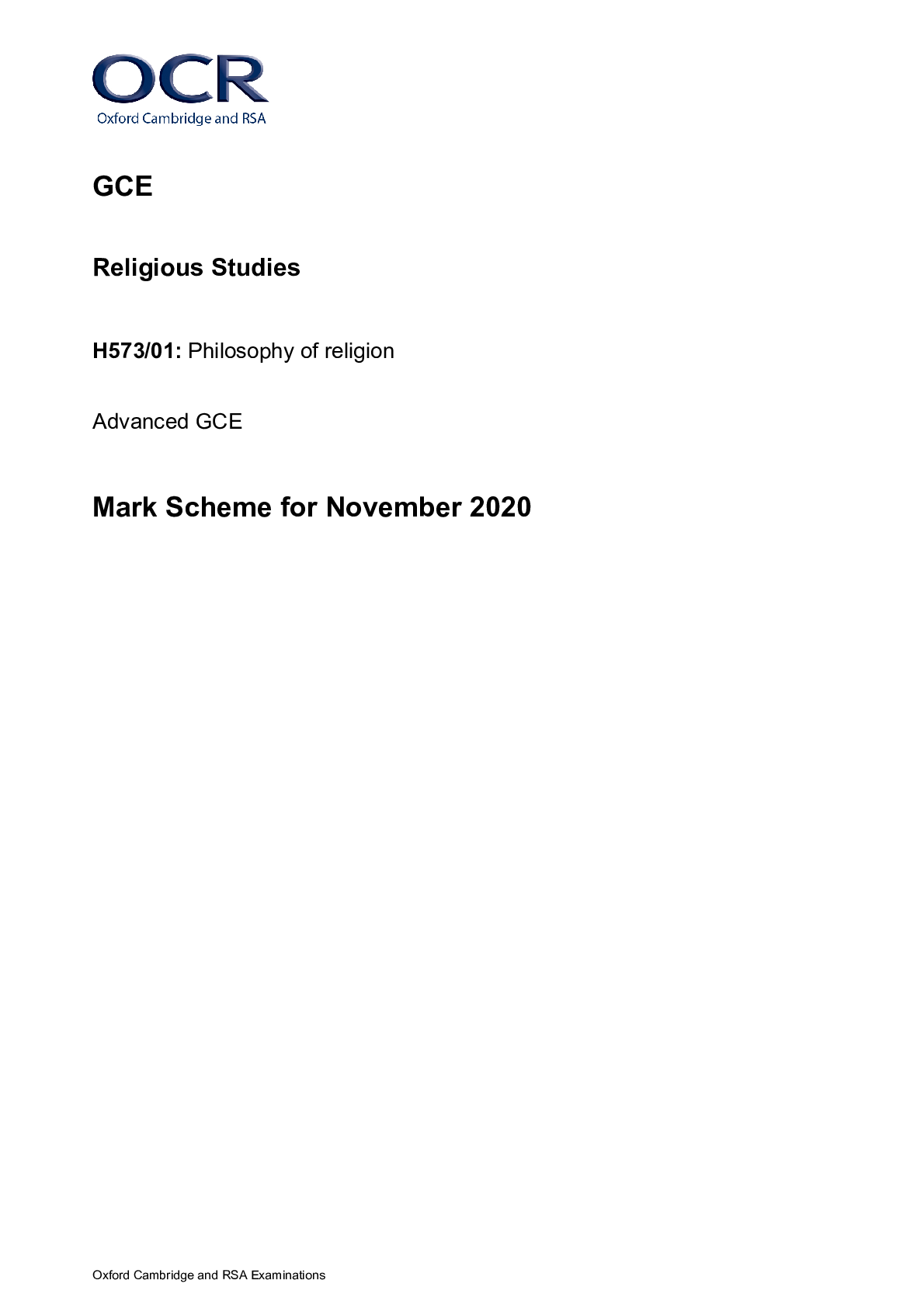
Buy this document to get the full access instantly
Instant Download Access after purchase
Add to cartInstant download
Reviews( 0 )
Document information
Connected school, study & course
About the document
Uploaded On
Oct 07, 2022
Number of pages
17
Written in
Additional information
This document has been written for:
Uploaded
Oct 07, 2022
Downloads
0
Views
69


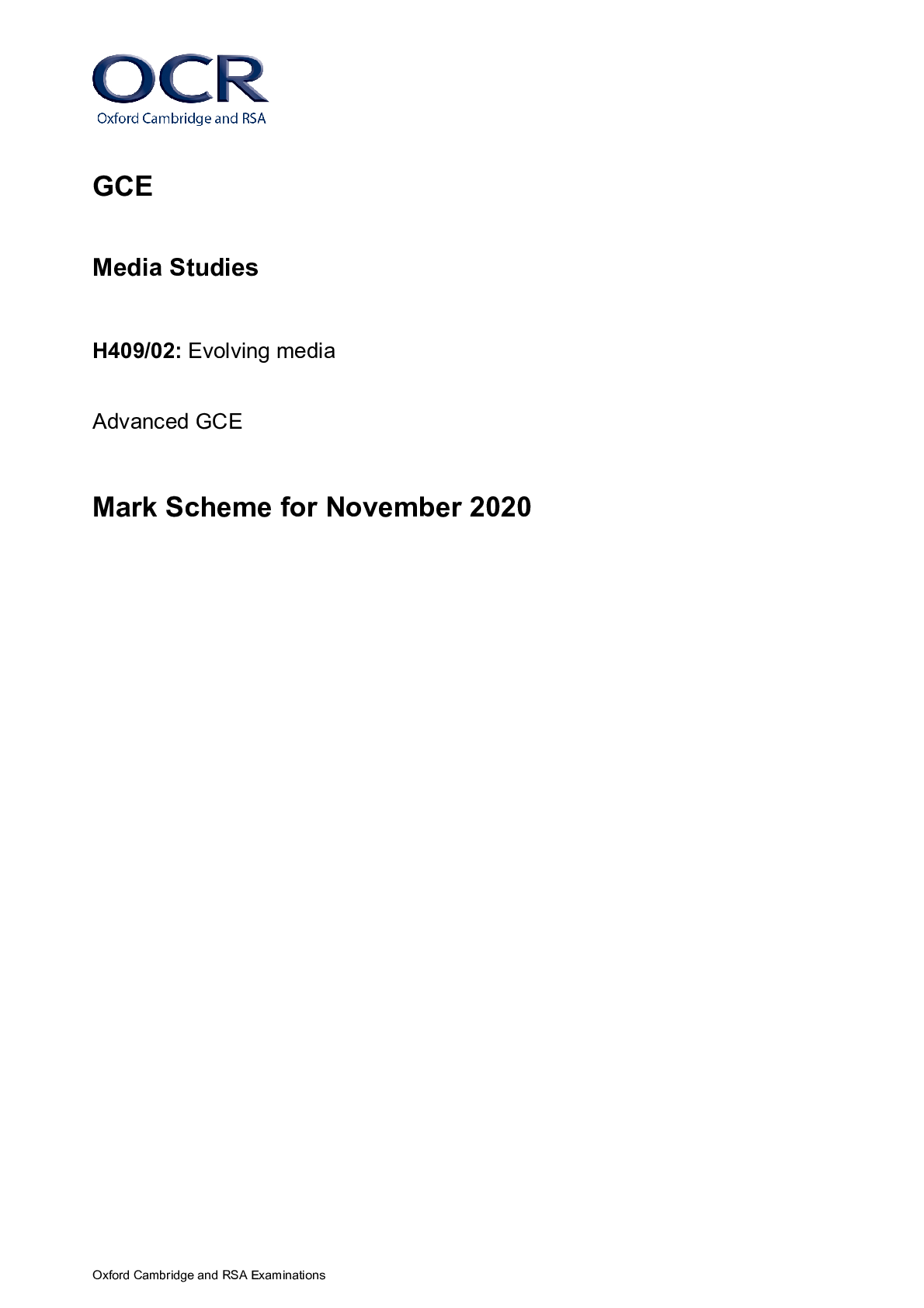
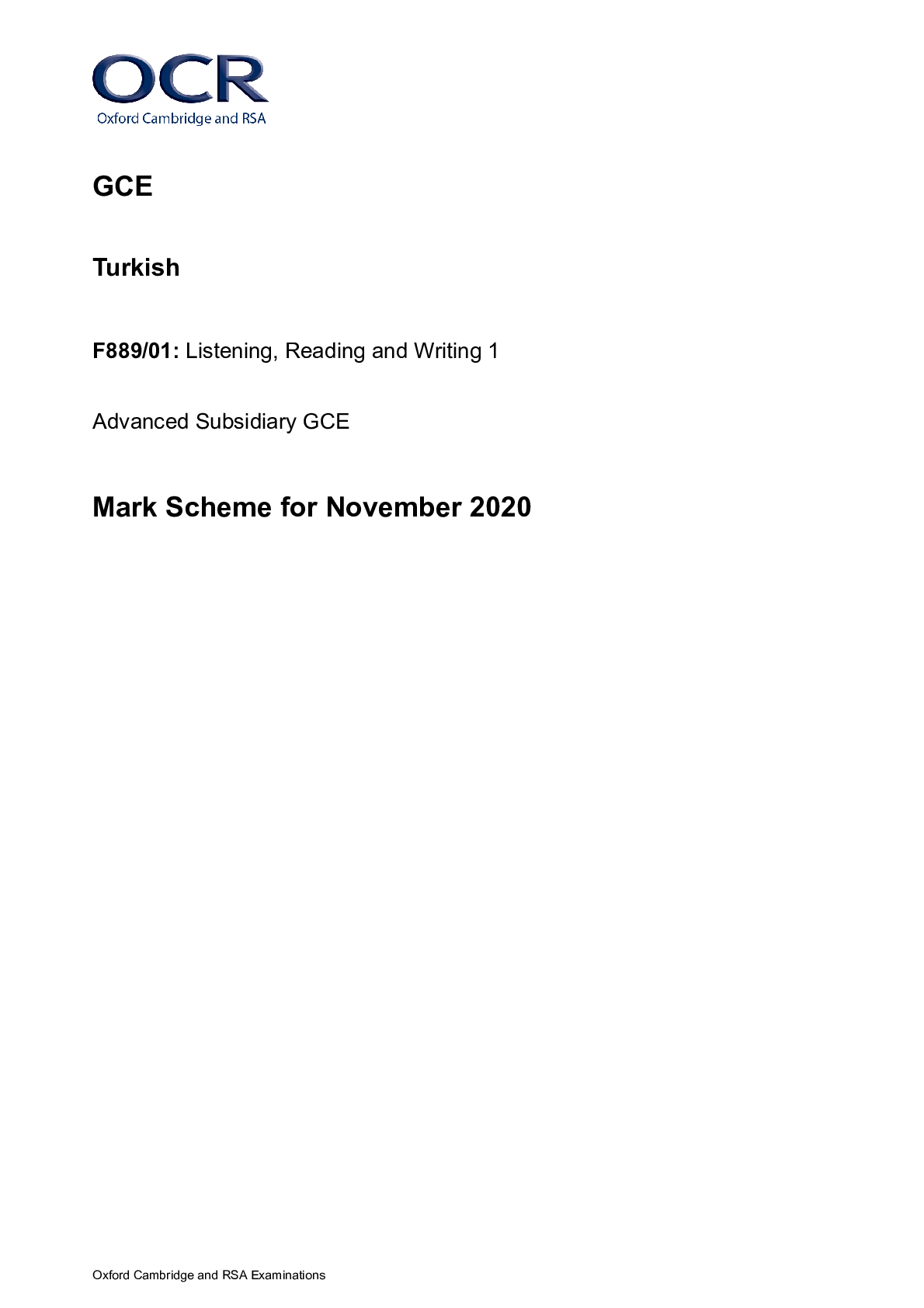
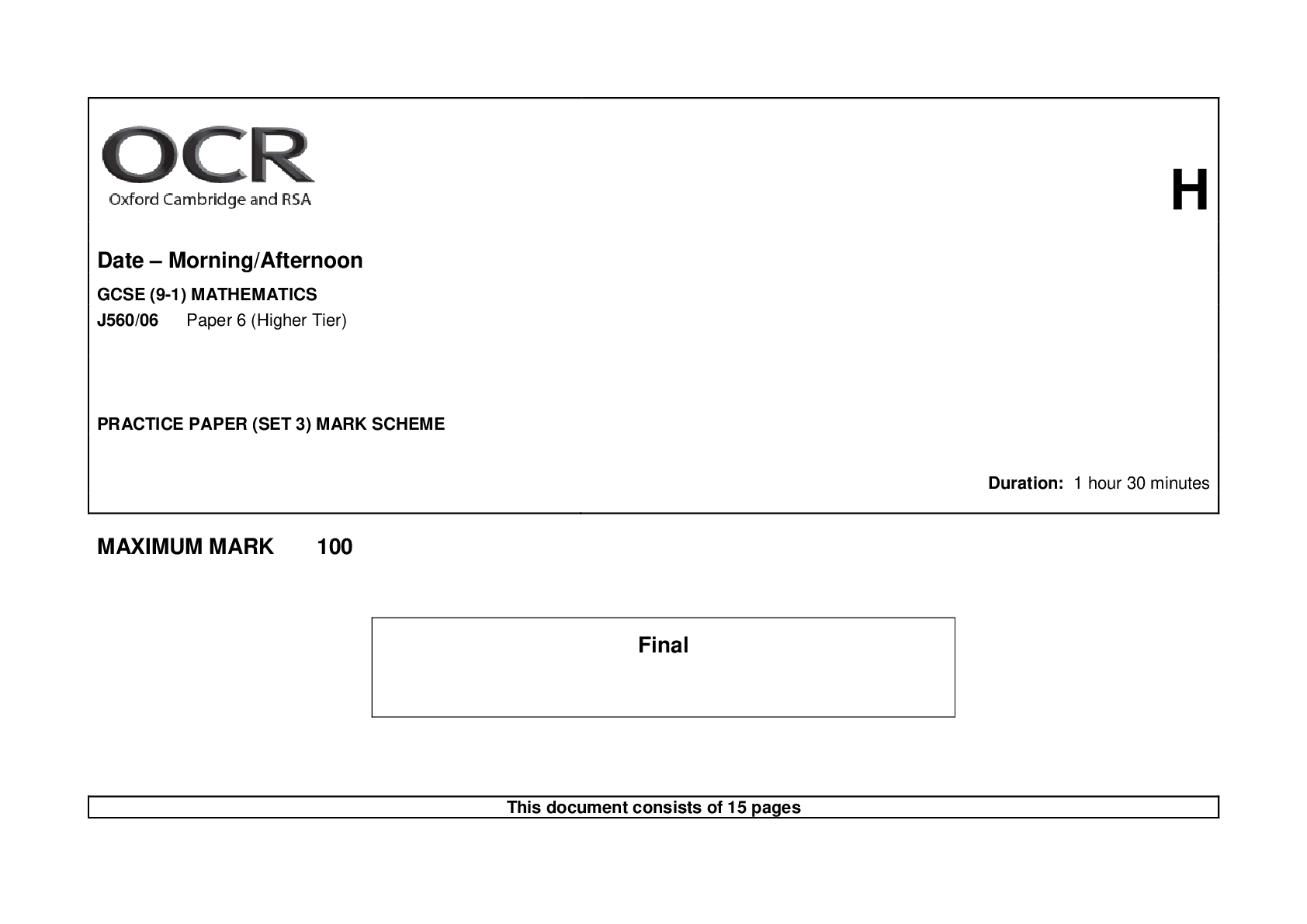


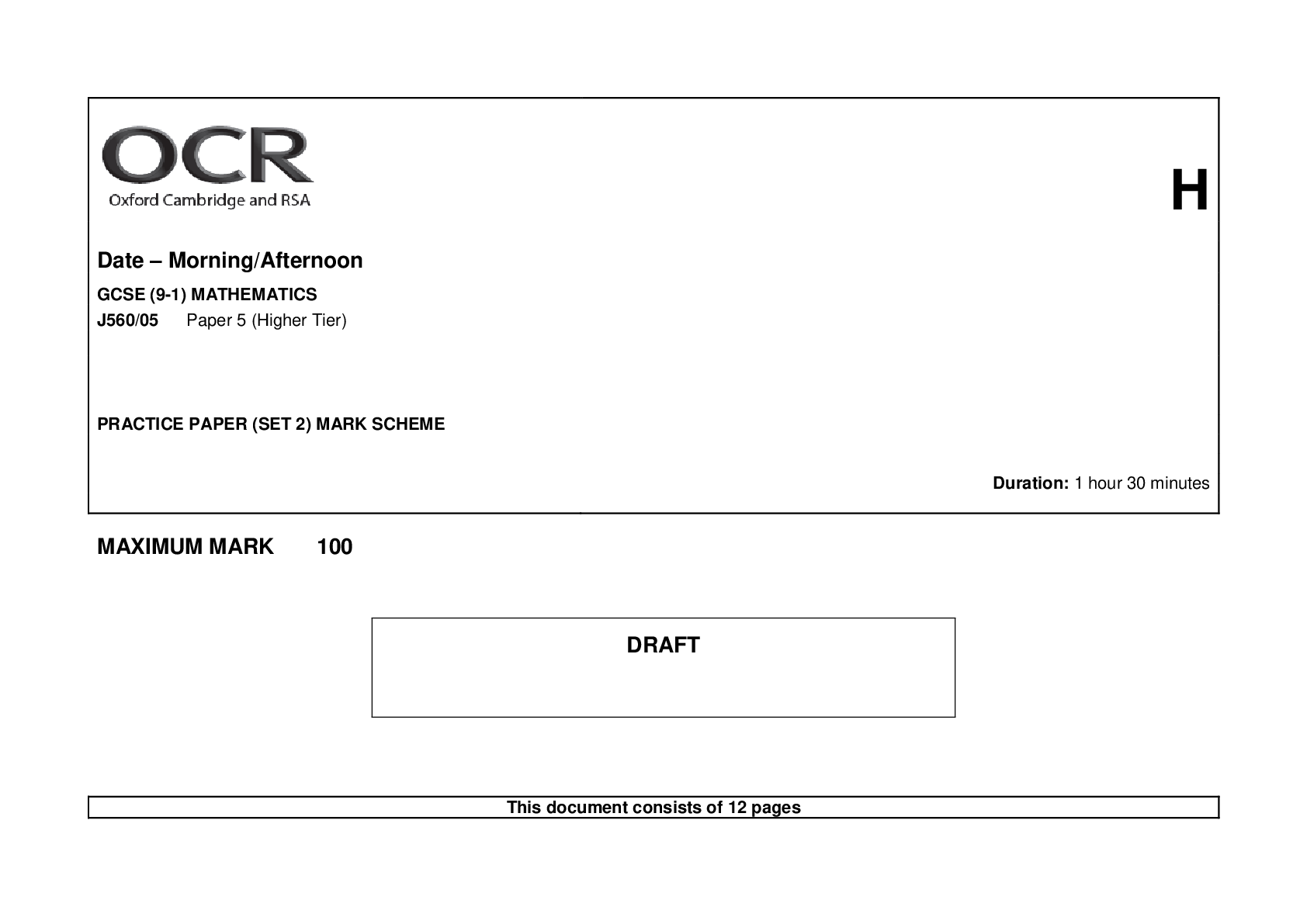
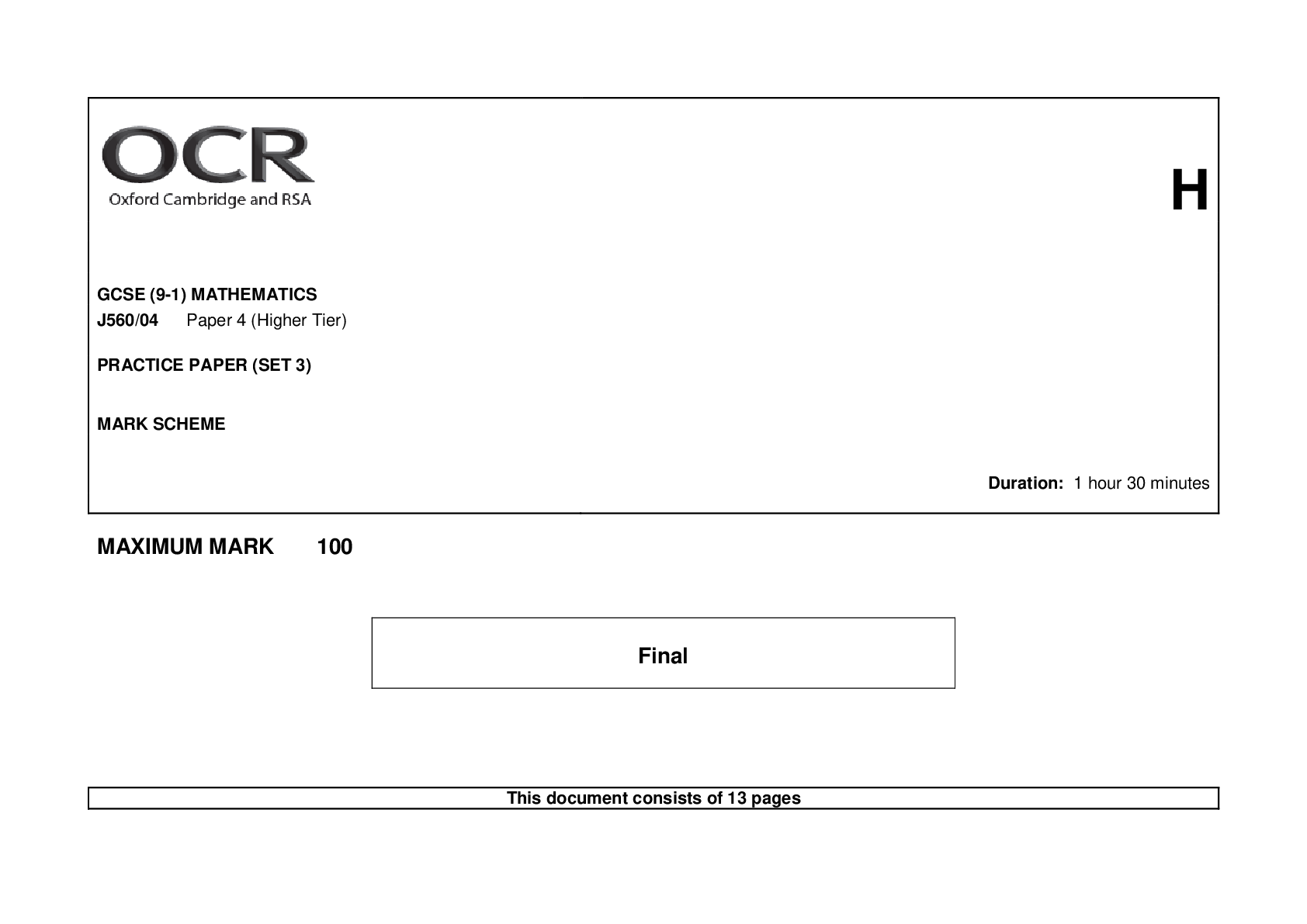



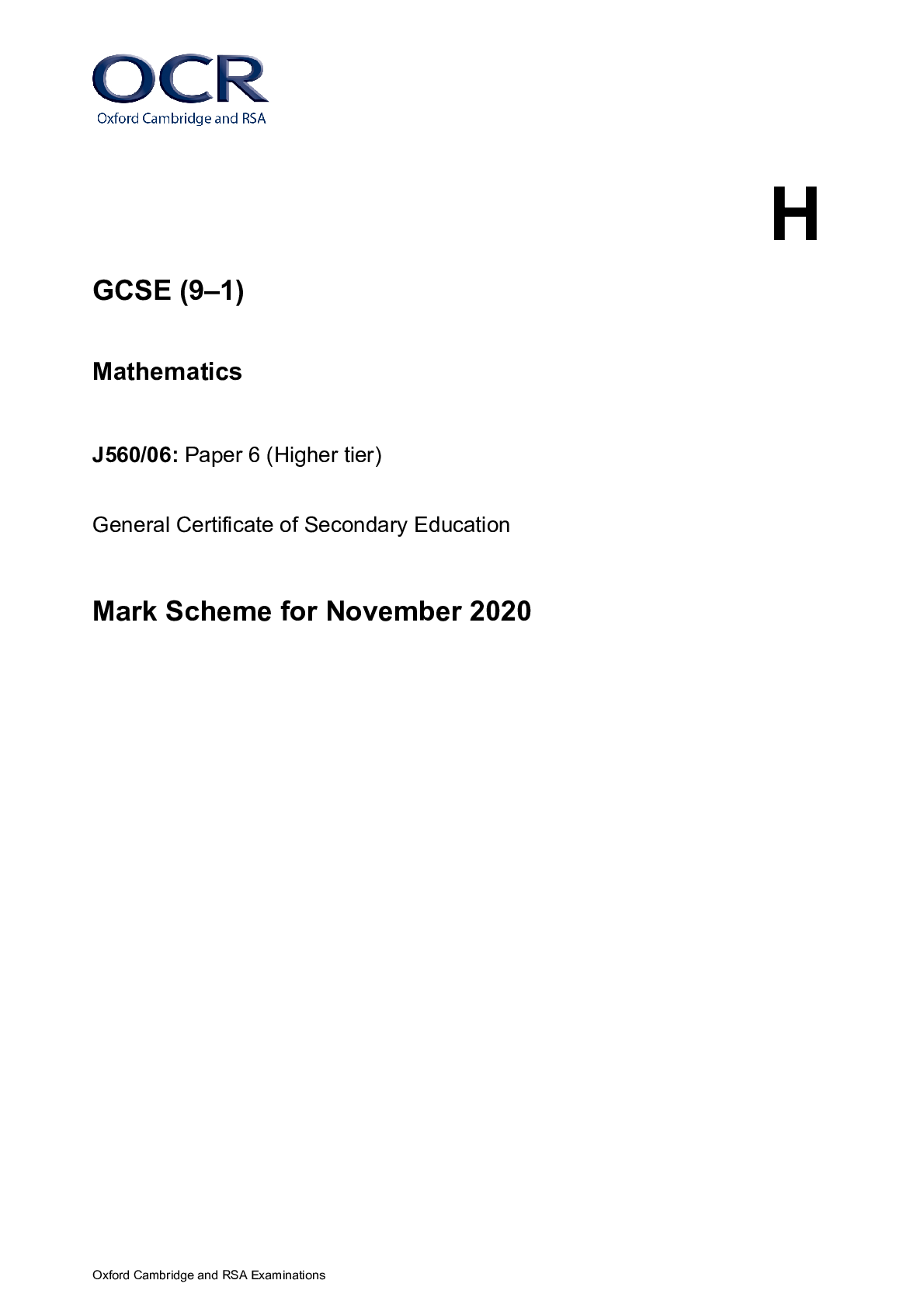
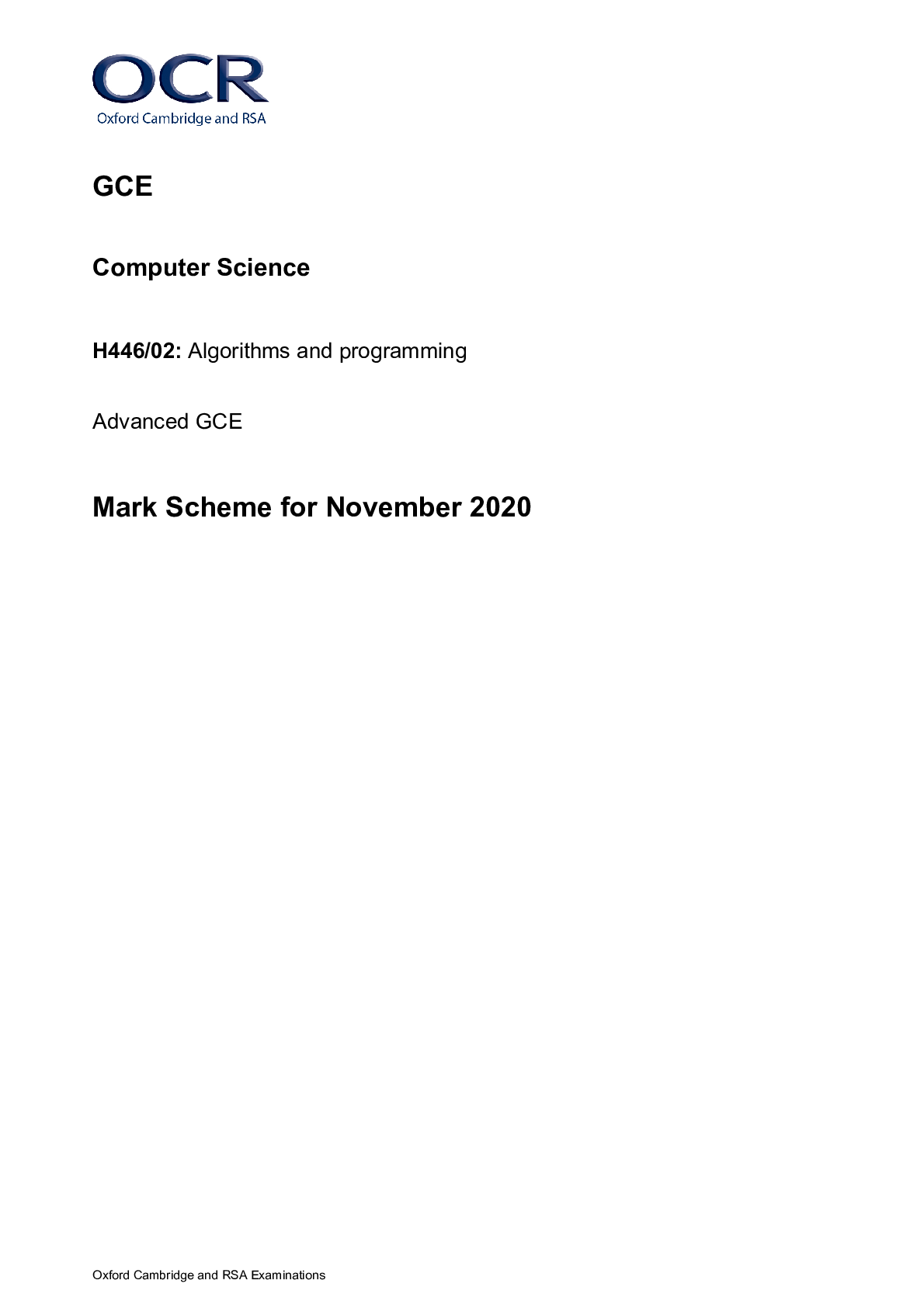
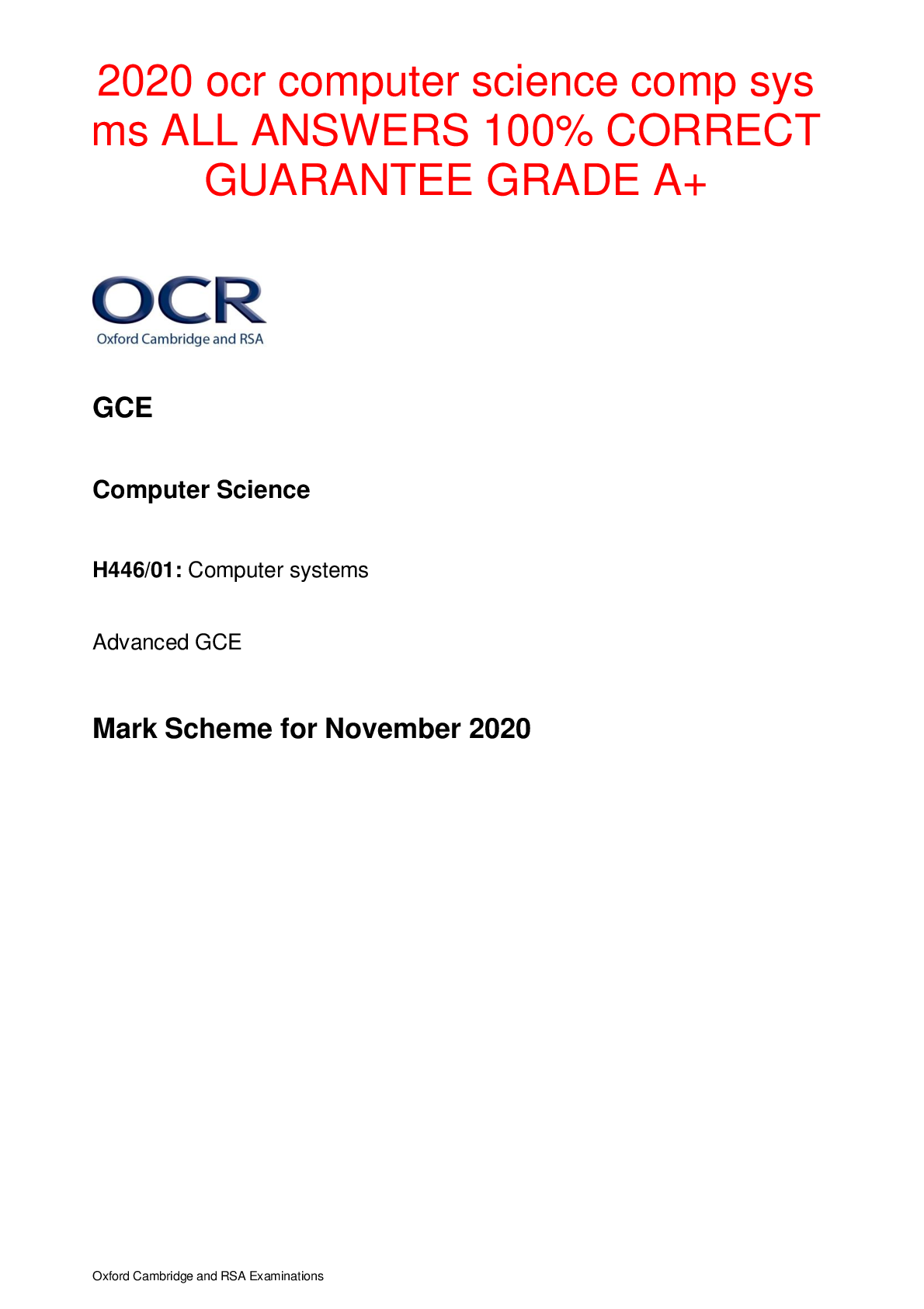

.png)
